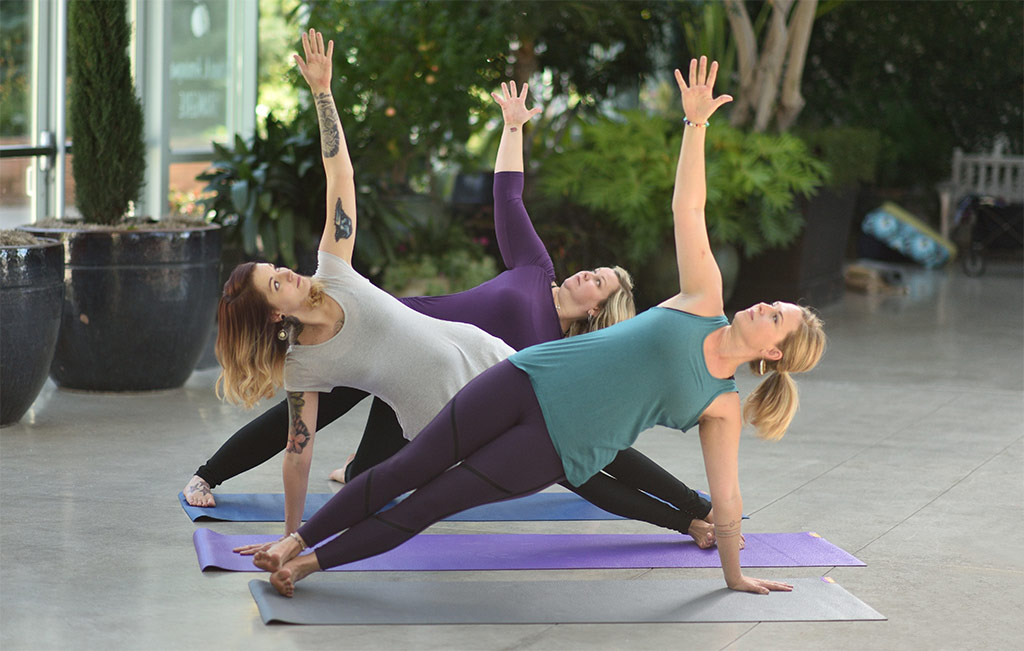
There was a time when yogis in America practiced on bare floors and bath towels. If you were lucky, your yoga class took place on a hardwood floor, one with a finish that had at least a modicum of friction. Reality was, most of us ended up sliding around on linoleum, wood, concrete or carpet.
Standing poses and Adho Mukha Svanasana (Downward Facing Dog Pose) were an exercise in frustration. No matter how much we might have wanted to open our hearts, expand into the light, etc., we were always holding back, trying to keep from ending up in a heap on the floor.
Hugger Mugger to the Rescue
The first nonskid mats were introduced to the Iyengar Yoga world by Angela Farmer in the mid to late ‘80s. These mats were cut from European carpet underlay. They were a godsend to those of us who’d been struggling against slick floors. Before long these unattractive but functional institutional-green mats were in every class and workshop I attended around the country. But because these mats were not made to withstand human body chemistry and lots of movement, their surface began peeling under our hands and feet within a few months.
That’s when Sara Chambers, founder of Hugger Mugger Yoga Products, decided to develop a sturdier, stickier yoga mat. In 1990, she worked with a U.S.-based company to develop the Tapas® Mat, the first-ever nonskid mat designed specifically for yoga. The same U.S. company still makes our Tapas® Original and Tapas® Ultra yoga mats. All the other mats on the market today are based on Sara’s original design for a yoga mat that could provide a stable, sticky surface.
Most yoga mats on the market are made from PVC. On the upside, PVC is incredibly durable. I still have a few Tapas® Original Mats from the first batch Hugger Mugger sold in 1990, and they haven’t peeled or worn through. On the downside, most PVC is a petroleum-based product. Some PVC mats on the market contain toxic heavy metals and phthalates. Hugger Mugger’s Tapas® Mats have never contained these substances.
Eco-friendliness is not simple. The balance for each yogi is to decide whether buying biodegradable, sustainable mats is more or less eco-friendly than buying a mat that you may never have to replace. This, of course, is a question that each of us answers for ourselves. It is why Hugger Mugger continues to offer many options. Sustainable options include mats made from PER (Polymer Environmental Resin), TPE (Thermoplastic Elastomer), natural rubber, jute and PER, and a combination of vegetable oil- and petroleum-based PVC.
Any mat will last longer if it is cared for. Depending on what mats are made from, the care can be quite different. Here’s a list of all our mats:
PVC-based mats: Tapas® Original Yoga Mat, Tapas® Ultra Yoga Mat
PER-based mats: Tapas® Travel, Nature Collection, Nature Collection Ultra, Gallery Collection Ultra
Natural rubber mats: Para Rubber, Para Rubber XL
TPE mats: Earth Elements 5 mm Mat
Natural fiber mat: Sattva Jute Yoga Mat
Fabric mats: The Yoga Towel and Cotton Yoga Rug
Here’s a post that details how to choose the best yoga mat for your practice.

Thanks for your valuable information. I agree!!! Life of any object whether it is a yoga mat or electronic gadget is directly proportional to its care by the owner. If you give value to your belongings and maintain them properly, they last very long. I prefer cloth mats over any other mats. They are quite comfortable and easy to wash. Get high quality yoga products from Yoga Mad, according to your need.
Very informative. This definitely helped me to choose a perfect yoga mat. Thank You.
Great! Just curious: Which mat did you end up buying?
Thank you so much for sharing this informative blog. It helped me choose the right yoga mat for me.
Hi, any idea how much the first yoga mats were sold for?
It’s amazing how a simple innovation like the sticky yoga mat transformed the practice. A reminder of how even small changes can leave a lasting impact.
So true! When I first started practicing, standing poses were almost impossible because the floor where the classes were taught was slippery. The sticky mats were a huge innovation.